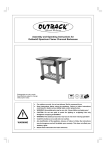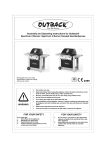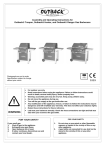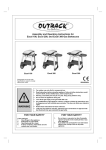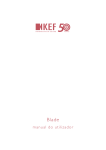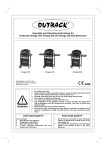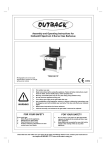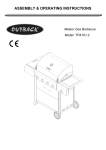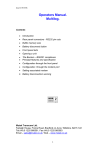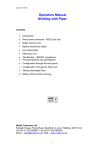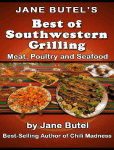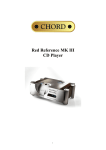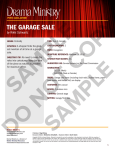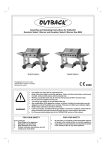Download Assembly and Operating Instructions for ONYX 4 Burner with Side
Transcript
Assembly and Operating Instructions for ONYX 4 Burner with Side Burner Gas Barbecue Photographs are not to scale. Specifications subject to change without prior notice. • • • • • • WARNING • • 0359 For outdoor use only. Read instructions before using the appliance. Failure to follow instructions could result in death, serious bodily injury, and/or property loss. Warning: accessible parts may be very hot. Keep young children away. Do not move the appliance during use. Turn off the gas supply at the gas cylinder after use. Any modification of the appliance, misuse, or failure to follow the instructions may be dangerous and will invalidate your warranty. This does not affect your statutory rights. Retain these instructions for future reference. Leak test your barbecue annually. Check the hose connections are tight and leak test them each time you reconnect the gas bottle. FOR YOUR SAFETY FOR YOUR SAFETY If you smell gas: 1. Shut off gas to the appliance. 2. Extinguish any open flame. 3. Open barbecue lid or hood. 4. If odour continues, discontinue use and contact your local dealer. 1. Do not store or use petrol or other flammable vapours or liquids in the vicinity of this or any other appliance. 2. A gas cylinder not connected for use shall not be stored in the vicinity of this or any other appliance. Parts List Quantities vary according to model purchased. Specifications subject to change without prior notice. CODE HOOD BODY TROLLEY PART QTY ONYX 4 Burner with Side Burner A1 Hood (pre-assembled to body) 1 3 A2 Hood Handle 1 3 A3 Heat Indicator Assembly 1 3 A4 Warming Rack 1 3 B1 Barbecue Body 1 3 B2 Burner 4 3 B3 Control Panel 1 3 B4 Knob (four pre-assembled) 5 3 B5 Side Burner Valve/Hose/Regulator Assembly 1 3 B6 Flame Tamer 2 3 B7 Cooking Grill 1 3 B8 Cooking Griddle 1 3 B9 Ignition Button (one pre-assembled) 2 3 B10 Drip Tray Left Bracket 1 3 B11 Drip Tray Right Bracket 1 3 B12 Drip Tray Handle 1 3 B13 Drip Tray 1 3 C1 Side Burner 1 3 C2 Side Burner Grid 1 3 C3 Side Burner Shelf 1 3 C4 Knob Bezel (four pre-assembled) 5 3 C5 Side Burner Drip Tray 1 3 C6 Side Shelf 1 3 C7 Cabinet Top Panel 1 3 C8 Cabinet Left Panel 1 3 C9 Cabinet Right Panel 1 3 C10 Cabinet Back Panel 1 3 C11 Cabinet Bottom Panel 1 3 C12 Left Front Leg 1 3 C13 Left Rear Leg 1 3 C14 Right Front Leg 1 3 C15 Right Rear Leg 1 3 C16 Door 2 3 C17 Door Retaining Spring Axle 2 3 C18 Door Retaining Axle 2 3 C19 Door Catch 2 3 C20 Wheel 2 3 C21 Short Axle 2 3 C22 Hubcap 2 3 C23 Lockable Caster 2 3 D1 ST4.0X10 Screw 16 3 D2 M4x10 Bolt 4 3 D3 M5x15 Bolt 4 3 D4 M5x35 Bolt 8 3 Pre-Assembled Component D5 Ø5 Washer H Quantity varies according to model D6 M5 Nut purchased 4 3 12 3 s Appearance, size, and may differ according to model purchased 12 HARDWARE D7 construction M6x15 Bolt 3 2 8 3 M6 Nut 8 3 D10 Body Spacer 8 3 D11 Wi 8 3 D8 M6x80 Bolt D9 N t Parts Diagrams Quantities vary according to model purchased. Specifications subject to change without prior notice. B8 B7 A4 B6 A2 A1 C2 A3 B4 C1 D6 C3 C6 B1 B2 B9 C4 B3 B12 B4 C5 B13 B10 B11 B5 C7 C13 C12 C15 C14 C9 C8 C10 C17 C16 C11 C18 C20 C22 C23 C21 C19 3 Assembly IMPORTANT! • Tools Required: Medium size flat blade or Phillips/Crosspoint screwdriver, adjustable spanner or metric spanner set • The assembly of this barbecue requires 3 people. • Carefully unpack the parts from the box and remove all internal packaging before commencing assembly. All loose items including the grills, flame tamers and warming rack must be removed from the body. • Whilst every care is taken in the manufacture of this product, care must be taken during assembly in case sharp edges are present. 1 L/H R/H Attach the Left and Right Legs (C12, C13, C14, C15) to the Cabinet Bottom Panel (C11) using the M5x35 Bolts (D4) and M5 Nuts (D6) as shown. (The bottom panel with door catch assembling hole should be located at front after assembly) 2 R/H L/H Insert Short Axles (C21) through Wheels (C20), Axle Washers (D12) and guide holes in left legs and secure with M8 Nuts (D13). Screw the Lockable Caster (C23) into the end of the right legs and hand tighten until it stops. Snap the Hubcaps (C22) into wheels. 4 3 L/H R/H ST4.0x10 Screw Attach the Cabinet Left Panel (C8) and Cabinet Right Panel (C9) onto the bottom panel and legs using ST4.0x10 Screws (D1) as shown. 4 ST4.0x10 Screw L/H R/H Attach the Cabinet Back Panel (C10) onto rear legs using ST4.0x10 Screws (D1) as shown. 5 5 Attach the Cabinet Top Panel (C7) onto left panel and right panel using M6x15 Bolts (D7) and M6 Nuts (D9). 6 Attach the Door Catches (C19) to the top and bottom panels using M6x15 Bolts (D7) and M6 Nuts (D9). 6 7 R/H L/H Attach the Side Shelf (C6) and Side Burner Shelf (C3) using M6x15 Bolts (D7) as shown. NOTE: Side table supports have slots for easy assembly. 8 Body Spacer Align guide holes in side table supports, holes in legs, then insert eight M6x80 Bolts (D8) through the aligned holes, Body Spacers (D10). Do not let the bolts over the spacers, it is easy to attach body to cabinet assembly. Place hood and body assembly onto position, screw the bolts through both sidewall of body and secure with Wing Nuts (D11) as shown. (Three people required) 7 9 M5 Nut Attach Drip Tray Right Bracket (B11) onto body using M5x15 Bolts (D3) , Ø5 Washers (D5) and M5 Nuts (D6) as shown. Repeat for Drip Tray Left Bracket (B10). Make sure that the tabs which stop drip tray should be located at front. 10 Attach the valve of Side Burner Valve/Hose/Regulator Assembly (B5) and Knob Bezel (C4) onto side burner shelf using M4x10 Bolts (D2) as shown. 8 11 Feed the venturi tube of the Side Burner (C1) through the hole in the side burner shelf, and slide the end of the venturi tube over the tip of the valve. Fix side burner onto bottom of side burner shelf using a M4x10 Bolt (D2) as shown. 12 Unscrew the retaining nut from Ignition Button (B9), insert the button through the hole beside side burner knob and secure with the retaining nut. Connect the ignition wire onto end of ignition button. 9 13 Attach Side Burner Drip Tray (C5) onto bottom of side burner shelf using a M4x10 Bolt (D2). 14 Place the Side Burner Grid (C2) onto the burner. Press the Burner Knob (B4) on the vale stem. 10 15 Retaining Nut Retaining Axle Spring Plastic Crust Retaining Nut Washer Retaining Axle Attach the Door Retaining Spring Axles (C17) and Door Retaining Axles (C18) onto Doors (C16) as shown. Pull down the pins on the insides of the doors and insert the doors into place as shown. The axle with spring should be located on top. 16 Lay the Flame Tamers (B6), Cooking Grill (B7), Cooking Griddle (B8) into the barbecue body as shown. The grill should be set directly over the flame tamers on LEFT side of body. 11 17 Insert the Warming Rack (A4) in to the hood. Slide the Drip Tray (B13) underneath the barbecue body from back of body. 18 Assembly is now complete. All joints and connections must now be leak tested before using the barbecue. For details of leak testing, please refer to instructions on Page 15. 12 ESSENTIAL INFORMATION Please read instructions before using your barbecue. BEFORE YOU USE YOUR BARBECUE (also see installation) • • • Perform a leak test. This is the only safe and sure way to detect any gas leaking from joints and connections of the barbecue after assembly. Follow the leak test instructions on page 15. Check that the gas hose is free of any tension, twisting, cuts, or cracks. Make sure your barbecue is in a safe place. It must be outdoors, on level ground and not below ground level. Ensure that the barbecue is at least 1 metre away from any flammable materials, including trees and fences and that there are no heat sources near the barbecue (cigarettes, open flames, spark etc.) Check that you have the correct gas bottle and regulator for your barbecue. Never place the gas bottle inside the trolley cabinet. GETTING STARTED (also see operation) • Open the hood of your barbecue. Never light your barbecue with the hood closed. Turn the gas regulator • • • • • • • • • or gas bottle valve to the ‘on’ position. Push the leftmost control knob and turn it to the high position. Press the ignition button in the left of control panel rapidly several times until the leftmost burner is lit. If burner fails to ignite, turn control knob to the off position and turn gas off at the bottle or regulator. Wait five minutes, then repeat the above steps. After successful lighting, light the remaining burners from left to right, make sure each burner is alight before attempting to light the next. If the burner fails to ignite after following above procedure, turn all the knobs to the off position. Close the gas valve on the gas bottle. Wait 5 minutes, then repeat the above steps. If the barbecue still fails to light, please refer to the manual ignition instructions on page 16. Once the burners are lit, turn all the main burners to the high setting for 3-5 minutes to pre-heat the barbecue. This should be done before each session. When pre-heating is complete, cooking can begin, taking extra care if the burners are used in the high position. To prevent food sticking, we recommend that you use a long handled brush to apply a light coat of cooking oil to the grill and griddle before each barbecue session. Side Burner - Open the lid of the side burner. Never light the side burner with the lid closed. Turn the gas regulator or gas bottle valve to the ‘on’ position. Push the side burner control knob and turn it to the high position. Press the ignition button in side burner shelf panel rapidly several times to light the burner. If the burner fails to ignite after following above procedure, turn the side burner knob to the off position. Close the gas valve on the gas bottle. Wait 5 minutes, then repeat the above steps. If the burner still fails to light, please refer to the manual ignition instructions on page 16. If a fat fire should occur during cooking, and if safe to do so, turn off the burners and the gas at the bottle and wait for the fire to go out. Do not pull out the drip tray or douse with water. Never douse a barbecue with water. Never move a barbecue when lit. Never leave a lit barbecue unattended Never handle hot parts with unprotected hands Keep children, animals, and elderly people a safe distance from a lit barbecue. WHEN YOU HAVE FINISHED COOKING (also see care and maintenance) • Turn all the main burners to the high position for 3 to 5 minutes to burn off any food residue from the • cooking surfaces and burners. When the barbecue has cooled, the burnt residue can be easily removed using a damp, non abrasive cloth on the cooking surfaces and a brass wire brush on the burners and flame tamers. We do not recommend putting grill and griddle in a dishwasher due to their weight. When the barbecue has cooled, scrape away any food and fat residue from the drip tray and discard. These routines must be completed after each session. 13 STORAGE • Ensure the barbecue is properly cooled. • If you intend to leave your barbecue outside, make sure it is protected from the elements with a heavy duty cover. These are available from most Outback® stockists. • Store your barbecue in a cool dry place. It must be inspected on a regular basis as damp or • condensation can form which may result in damage to the barbecue. It may be necessary to dry the barbecue and the inside of the cover if used. Mould can grow under these conditions and should be cleaned and treated if required. Chrome plated warming racks etc. should be coated with cooking oil. Wrap the burners in aluminium foil to help prevent insects or other debris from obstructing the burners. The gas bottle must be always be disconnected from the barbecue and stored in a well ventilated area at least 1 metre away from any fixed ignition source. Do not store inside residential accommodation. Never store cylinders below ground level (e.g. cellars). Do not let children tamper with bottles. IMPORTANT INFORMATION • For use with LPG bottled gas only. A fixed pressure regulator of 28-30mbar must be used for butane or • • • • • • • 37mbar for propane. The use of an adjustable regulator is dangerous and must never be used with this barbeque. This product is for outdoor use only. Do not use indoors. Do not use below ground level as LP gas is heavier than air, so if a leak occurred the gas collected at a low level could ignite in the presence of a flame or spark. Do not use or store gas bottles on their side as this could allow liquid gas into the supply pipes with serious results. Never place the gas bottle inside the trolley cabinet. Leak test the barbecue annually. Check that the hose connections to the barbecue are tight and leak test whenever the gas bottle is reconnected. Always turn off the gas at the bottle when not in use. Do not use aerosols near this barbecue. GAS, REGULATOR AND HOSE This barbecue, hose, (and regulator, if included), are approved for use in the UK. The barbecue is also approved for use in other countries as listed on the control panel and in the Technical Specifications included in the barbecue manual. If the barbecue is intended to be used outside of the UK, the consumer MUST seek advice from the local qualified gas supplier as to the suitability of the barbecue and with regards to the correct hose and regulator that they should be using. This barbecue can run on propane or butane LPG (liquid petroleum gas) bottled gas. For optimal performance we recommend the use of propane gas which is supplied under a number of different names and bottle colours. Butane gas can be used but it may restrict the heat output available from the burners, particularly when the gas temperature falls below +10 degrees Celsius. If in doubt, please consult your gas dealer/distributor. For optimal performance, we suggest the following: MODEL BUTANE MINIMUM BOTTLE SIZE ONYX 4 Burner with Side Burner x PROPANE MINIMUM BOTTLE SIZE 10kg Suitable regulator: Butane – outlet pressure 28-30mbar Propane – outlet pressure 37mbar Hose • Check that the gas hose does not touch any part of the barbecue that may become hot during operation. 14 • • If the hose shows any sign of damage it must be replaced with a hose that is suitable for use with LPG (liquid petroleum gas) and meets British Standards. The length of hose should not exceed 1.5 metres. Please note: the date on UK orange hose is the date of manufacture – not the expiry date. You must have the correct gas bottle, regulator, and hose for the barbecue to operate safely and efficiently. Use of an incorrect or faulty regulator is dangerous and will invalidate the warranty on this product. If you are unsure, please check with your local gas dealer. INSTALLATION Precautions: • Only use this barbecue in a well-ventilated outdoor area. • Check that the barbecue is not placed UNDER any combustible surface. • The sides of the barbecue should never be closer than 1 metre to any combustible material. • Do not obstruct any ventilation openings in the barbecue body. • Confirm all control knobs are in the off position before connecting the regulator. • Always connect the regulator in accordance with the regulator and gas cylinder suppliers instructions. • The casters should always have the brakes on when the barbecue is in use. LEAK TESTING Always perform a leak test in a well-ventilated area. Step 1 - Confirm all control knobs are in the off position. Step 2 - Detach the barbecue control panel located across the front of the barbecue body by pulling off the control knobs and removing the control panel retaining screws. Step 3 - Turn on the gas at the gas cylinder or regulator Step 4 - Check for leaks by brushing a solution of ½ water and ½ liquid soap over all the gas system joints, including all valve connections, hose connections, and regulator connections. Step 5 - If bubbles form over any of the joints there is a leak • Turn off the gas • Retighten all joints • Repeat test • If bubbles form again do not use the barbecue and contact your local distributor for assistance. OPERATION Your barbecue is not designed to be used with more than 50% of the cooking area as a solid plate – this includes baking dishes. If more than 50% of your cooking area is covered by a solid cooking surface, the barbecue could overheat causing damage that is not covered by warranty. Grill cooking The burners heat the flame tamers beneath the grill that, in turn, heats the food. The natural juices produced during cooking fall onto the flame tamers and vaporise to form smoke. The smoke then rises and ‘bastes’ the food, giving it that unique barbecued flavour. More even cooking of food will be achieved with the hood down which will also hold the heat in. This should only be done with the burners on a low to medium setting. Griddle Plate Cooking The burners heat the griddle plate directly, which then cooks the food on contact. Plates allow for the cooking of smaller items, such as seafood, which could fall through the spaces of a grill. They are also suitable for cooking items that require high-temperature/short-duration cooking, such as vegetables and smaller cuts of fish. Similarly, it can be used in exactly the same way as a griddle in the kitchen, for searing steaks, cooking eggs, etc. Alternatively, it can be used for heating pans or keeping food warm. 15 Roasting Hood Cooking Barbecues equipped with a roasting hood give the option of cooking with hood closed to form an ‘oven’ for roasting food, such as joints of meat, whole chickens, etc. When roasting, turn the burner directly under the food to the OFF position. Turn all other burners to a LOW to MEDIUM position and close the hood. Avoid lifting the hood unnecessarily as heat is lost every time the hood is opened. Use the temperature gauge to check the heat of the barbecue. DO NOT ALLOW YOUR BARBECUE TO OVERHEAT. Warming Rack Warming baskets are a convenient way to keep cooked food warm or to warm items such as bread rolls. Care should be taken to ensure any items placed in the warming basket are cooked through and do not continue to cook and drip fat or meat juices, which could drip onto the hood and down the back of the barbecue. Flare-up control Flare-ups will often occur when food is barbecued as fat and juices fall onto the flame tamers. Some fat is necessary to give the food its barbecued flavour but excessive fat can result in a flare-up. To avoid flare-ups it is advisable to trim excess fat from meat and poultry before grilling, use cooking sauces and marinades sparingly, and try to avoid very cheap cuts of meat or meat products as these tend to have high fat and water contents. Flare-ups occur more at the start of cooking, particularly with processed meat products, and it may be necessary to turn the burners down to their lowest setting to start with and then turning up at a later stage in the cooking process. The barbecue should also not be overloaded. Some parts of the cooking area are hotter than others. The hottest areas will be above the burners which will be where the flare ups will normally start. By leaving free space you can simply move the food away from the flare up to a cooler area until the flare up has subsided. Fat Fires The drip tray must be emptied and cleaned of food debris after each cooking session. If the barbecue is to be used for commercial use or large gatherings, it will be necessary to turn off and cool the barbecue every two hours to remove food debris from the drip tray, the time between cleaning may need to be reduced if very fatty foods or cheap meat products are being cooked. Failure to do this may result in a fat fire, which may cause injury and could seriously damage the barbecue. In the event of a fat fire; • If safe to do so, turn all control knobs to the ‘off’ position • Turn off the gas at the cylinder • Keep everyone at a safe distance from the barbecue and wait until the fire has burnt out. • Do not close the hood of the barbecue. • NEVER DOUSE A BARBECUE WITH WATER. IF AN EXTINGUISHER IS USED, IT SHOULD BE A POWDER TYPE. • DO NOT REMOVE THE DRIP TRAY • If the fire does not seem to be abating or appears to be worsening, contact your local Fire Brigade for assistance. Manual lighting instructions • Insert a long, lit match through the match-lighting hole in the right hand side of the body of the barbecue • • • • until the lit end is alongside the right hand burner. Push and turn the right hand control knob anticlockwise to the high position taking care to protect yourself from flames. When the burner is lit turn on the remaining burners from right to left. Confirm that each burner is lit before turning on the next burner To light the side burner place the lighted end of a long match alongside the side burner. Push and turn the side burner control knob anti-clockwise to the high position taking care to protect yourself from flames. If the right hand burner or side burner fails to light, turn off the gas and contact your local Outback dealer or our customer services department on (01622) 671771 for assistance. 16 CARE AND MAINTENANCE Do not leave the barbecue uncovered and exposed to the elements when not in use. Heavy duty covers are available from your Outback® stockist. Even when your barbecue is covered for its protection, it must be inspected on a regular basis as damp or condensation can form which may result in damage to the barbecue. It may be necessary to dry the barbecue and the inside of the cover. Any rust that is found that does not come into contact with the food should be treated with a rust inhibitor and painted with barbecue paint or a heat resistant paint. Chrome plated warming racks etc. should be coated with cooking oil. Burner Assembly To remove the burners (see photos): 1. Remove the cross channel from burner. 2. Remove the bolts/nuts from end of burner. 3. Gently pull the burner mouth away from the valve injector. 4. Lift the burner out and remove the screws from front of burner. To re-install the burners (not depicted): 1. Slide the burner mouth over the valve injector. The injector should sit centrally within the burner venturi tube. 2. Install the electrode onto the burner by screws. 3. Install the burner onto the body by bolts/nuts. 4. Install the cross channel onto the burner by screws. 1 • • • • • • • 3 2 4 Your burners have been preset for optimal flame performance. You will normally see a blue flame, possibly with a small yellow tip when the burner is alight. If the flame pattern is significantly yellow, this could be a problem caused by grease from cooking blocking the burner or spiders or other insects in the burner venturi. This can result in the flow of the gas and air mixture being restricted or blocked which may result in a fire behind the control panel causing serious damage to your barbecue. If this happens, the gas should be immediately turned off at the bottle. Burners should be inspected and cleaned on a regular basis in addition to the following conditions: 1. Bringing the barbecue out of storage. 2. One or more of the burners do not ignite. 3. The burner flame pattern is significantly yellow. 4. The gas ignites behind the control panel. To clean a burner, remove it from the barbecue. The outside of the burner can be cleaned with a brass wire brush. Clean the portholes with a pipe cleaner or piece of wire. Take care not to enlarge the portholes. Clean the air inlets on the end of the venturi tube with a bristle brush (i.e. an old toothbrush). Clean the venturi tube with a pipe cleaner or piece of wire. You may need a torch to see into the venturi tube to make sure it is clear. Turn the burner up on end and lightly tap against a piece of wood to dislodge any debris from inside. 17 Troubleshooting Problem Possible Cause Solution Burners will not light using the ignition system LP gas cylinder is empty Replace with full gas cylinder Faulty regulator Have regulator checked or replace Obstructions in burners Clean burners Obstructions in gas jets or gas hose Clean jets and gas hose Electrode or pushbutton Ignition wire is loose or disconnected Reconnect wire Electrode or wire is damaged Change electrode and wire Incorrect electrode gap The electrode needs to have a gap of approximately 3 to 4mm between its tip and the burner. Adjust if required. LP gas cylinder is empty Replace with full gas cylinder Faulty regulator Have regulator checked or replace Obstructions in burners Clean burners Obstructions in gas jets or gas hose Clean jets and gas hose LP gas cylinder too small Use larger gas cylinder Obstructions in burners Clean burners Obstructions in gas jets or gas hose Clean jets and gas hose Windy conditions Use BBQ in a more sheltered position Gas valve jammed Replace gas valve Burner will not light with a match Low flame or flashback (fire In burner tube - a hissing or roaring noise may be heard) Gas valve knob difficult to turn 18 Cleaning Material Where used Cleaning Method Recommended Chromium plated Warming Rack Wash with hot soapy water. A chrome cleaner may be used if required. To prevent rusting, wipe with cooking oil after rinsing and drying. Do not use abrasives. Stainless Steel Hood Door Control panel Wipe with a cloth wrung out in hot soapy water. A stainless steel cleaner may be used if required. Do not use abrasives. Burner Burners should be removed on a regular basis for inspection and cleaning as detailed on page 17. Flame tamers can be cleaned by scraping off excess deposits with a plastic or wooden scraper or a brass wire brush. Aluminum plated Flame Tamers Wash with hot soapy water. To remove any food residue, with a plastic or wooden scraper or brass wire brush. Cast Iron Grill Griddle Wash with hot soapy water. To remove any food residue, use a mild cream cleaner on a non-abrasive pad. Galvanised Drip tray Excess fat and food debris must be removed using a plastic or wooden scraper. This needs to be carried out between each use of the BBQ. Excessive build up is likely to lead to a fat fire which can be hazardous and damage the BBQ. This is not a fault in the BBQ and therefore is not covered by the terms of the warranty. If required, the drip tray can be washed in hot soapy water. Technical Specifications Model Name CE Approval Heat Input Burners 15.84kW 4 2.8kW 1 Injector Size 1.02mm ONYX 4 Burner 0359 359BT899 Side Burner 1.02mm 0.97mm 0.89mm 0.84mm 0.84mm 0.79mm 0.74mm Gas /Pressure 28-30 mbar Butane or 37 mbar Propane 30 mbar LPG mixture 37 mbar LPG mixture 50 mbar LPG mixture 28-30 mbar Butane or 37 mbar Propane 30 mbar LPG mixture 37 mbar LPG mixture 50 mbar LPG mixture Gas Consumption: ONYX 4 Burner: 1136g/hr Side Burner: 210g/hr Countries of Use: I3+ (28-30/37) I3B/P(30) I3B/P(50) I3B/P(37) BE, CY, CZ, EE, FR, GR, IE, IT, LV, LT, LU, PT, SK, ES, CH, GB, RO BG, CY, CZ, DK, EE, FI, GR, HR, HU, LV, LT, LU, MT, NL, NO, SK, SI, SE, TR, IS AT, DE, HU, SK, CH PL 19 OUTBACK UK LTD LIMITED 10 YEAR WARRANTY OUTBACK barbecues are warranted to the original purchaser against defects in materials and workmanship. Porcelain coated barbecue bodies, porcelain coated roasting hoods and stainless steel roasting hoods are warranted for a period of ten (10) years from the date of purchase. Stainless steel burners are warranted for a period of two (2) years from the date of purchase. OUTBACK UK will, within this period, supply replacements for defective parts free of charge provided that: ♦ ♦ ♦ ♦ The product has not been used for trade, professional or hire purposes. The product has not been subjected to misuse or neglect, including fat fires and flare ups or use of a faulty or incorrect regulator. The product has not sustained damage through foreign objects, substances or accidents. The care and maintenance instructions given in your Outback manual have been followed. This warranty is offered as an extra benefit and is in addition to the customers’ statutory rights. Outback UK does not warranty in any way the gas cylinder. If you have any queries regarding the assembly or use of your barbecue please contact Outback UK In the unlikely event that you experience problems with this barbeque, please contact: Customer Service Outback UK Unit 2 Farleigh Hill Tovil Maidstone Kent ME15 6RG Tel: 01622 671771 Fax: 01622 673101 e-mail: [email protected] website: www.outbackuk.com For reference and correspondence, record your serial number here. (See sticker on side of barbecue body.) Serial No.__________________ This number may be required when ordering spare parts or accessories. A part reference number may also be required where applicable. Published November 2009 20




















